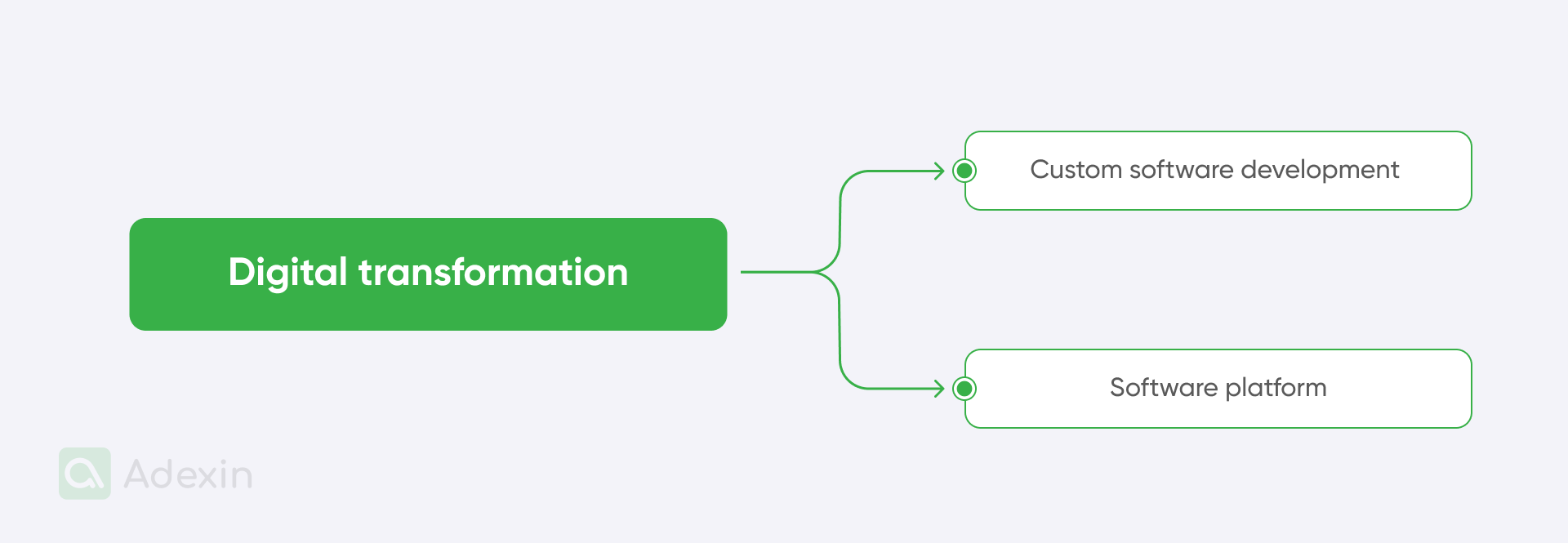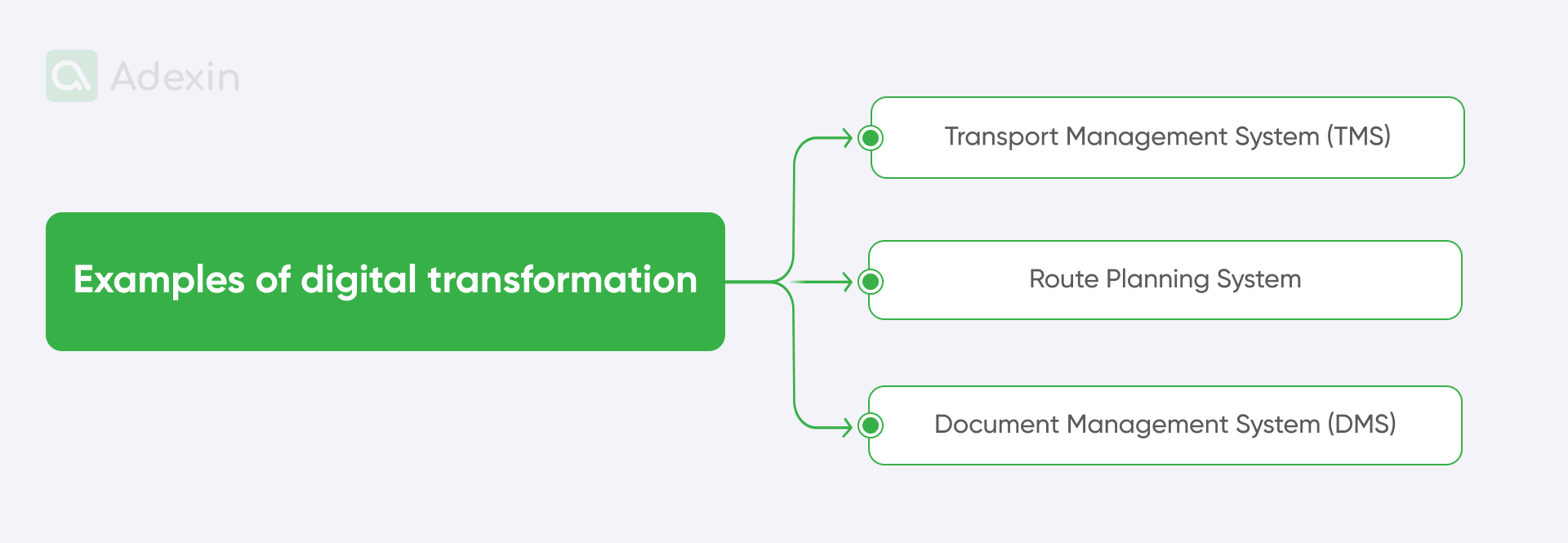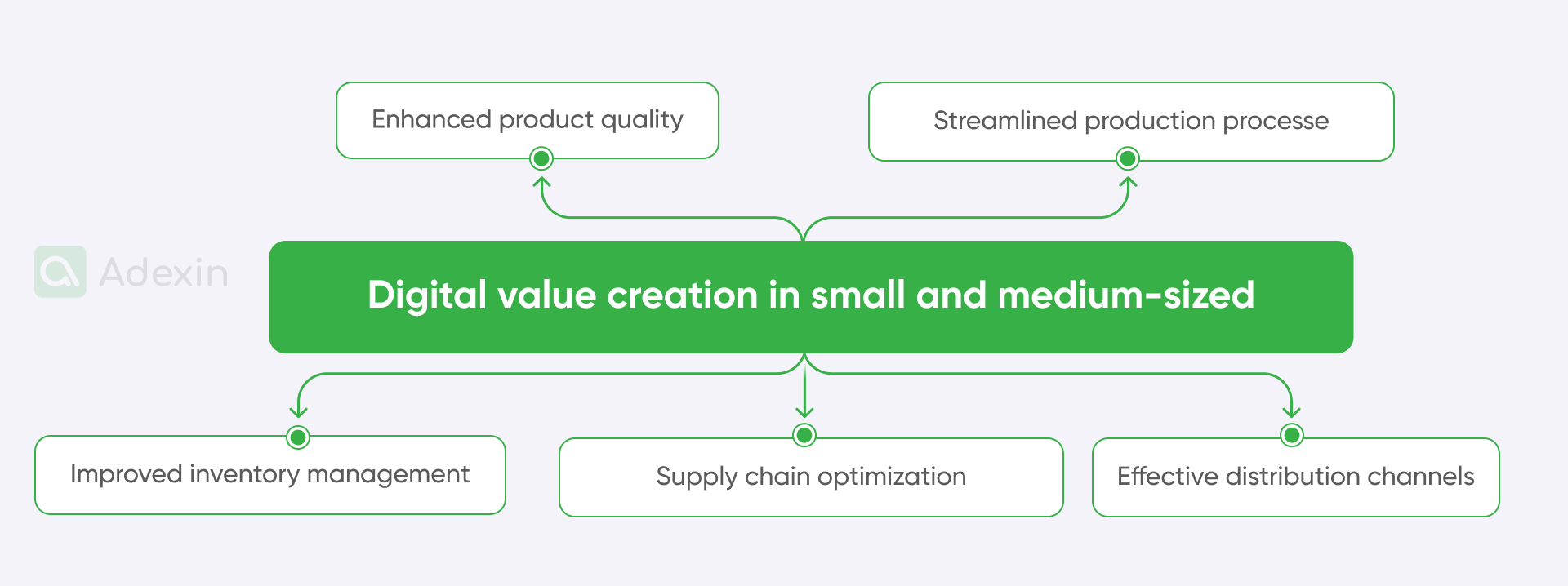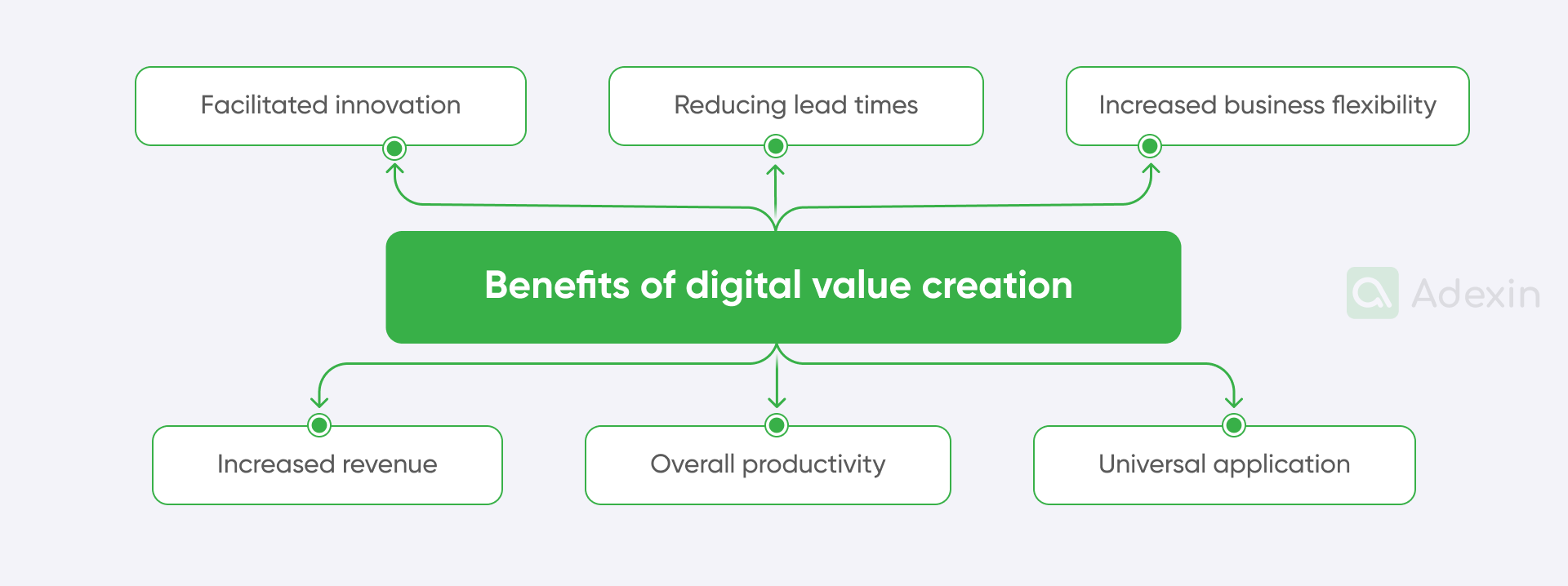The digital transformation contains essential elements throughout the entire implementation cycle of digital transformation. These elements involve the structure and precise digital strategy aligned with the vision and objectives. This article discusses embracing suitable digital technologies to foster innovation, efficiency, and adaptability in your operations. We move closer to the benefits of the value chain for small and medium-sized businesses.
Here, you'll be able to learn more about leveraging data through advanced analytics to glean valuable insights and facilitate informed decision-making. 2024 is a great time to advance your business and enhance productivity while removing bottlenecks. This can be achieved by optimizing existing processes and workflows. Do you want to know more? See the article below and get on the digital transformation journey into the sphere of knowledge to develop modern digital methods revealed in this material.
What is the digital transformation value chain?
The digital transformation involves analysis, making it a strategic analytical and decision-support tool that helps highlight areas where companies can generate value for their customers.
The value chain concept, developed by M.E. Porter, identifies primary and secondary activities of value creation within an organization that are crucial for operational efficiency. Primary activities include input logistics, production, output logistics, marketing, sales, and services, while secondary activities include procurement, technology, human resources, and company infrastructure.
The framework describes the full spectrum of activities required to deliver a product or service from concept to consumer delivery. Global value chains (GVCs) are created by fragmenting production processes.
They operate on a worldwide or regional scale and directly impact value-added generation. GVCs also play a crucial role in regional development by facilitating technology transfer and as a result of joint digital transformation efforts. They are also very close to skill acquisition and industrial modernization. Value chain analysis helps identify strategies for economic sector development.
We can now discuss that value chain analysis evaluates your business to maximize its potential based on the technology deployed within digital transformation. For example, we can use one of the Asian car producers.
Nissan, a car manufacturer, has launched a strategic innovation program to increase productivity and enhance product quality. In this case, Nissan integrated Siemens PLM software into its product design activities.
This advanced software offers comprehensive data for virtual validation, enabling the early identification of potential problems at the design stage. All stakeholders can explore various design alternatives by taking advantage of virtual testing capabilities before the production phase begins. Thus, the benefits for the business are evident.
Nevertheless, the entire example seems a bit overcomplicated when we consider implementing it at each stage. Therefore, we want to emphasize that depending on the business, these processes can vary, but the outcome is to capture any disproportions to protect your business while saving costs.
Here are the other elements that are included in the digital transformation:

Platformization as a successful digital transformation
Value creation through platformization includes developing and operating digital platforms that facilitate interactions and transactions between users in the entire supply chain.
These platforms serve as hubs for various stakeholders to connect, improve collaboration, and exchange value based on data exchange.
Based on our experience, we can say that the most crucial part when it comes to platformization is maintaining platform integrity with your business and technical requirements. Your software development partner should outline regulatory criteria that guide reliability.
What we have done previously was to prepare for any case that could cause a failure of the platform's performance. For this purpose, it is crucial to determine the so-called Failure Modes and Effects Analysis (FMEA), which helps obtain proper findings for regulatory criteria. Primarily, you need to be sure about these elements:
Identify the built-in system diagnostics to support system-level FMEA.
Identify failure modes (including communication) that should be handled by system-level FMEA.
Get sufficient detail of the potential failures and the effects of those failures.
This approach is only a glimpse of the first steps in successful digital transformation with custom platform development.
Value chain digital transformation with custom software development
Custom software development enables companies to use data analytics by providing solutions tailored to specific business needs and integrating various systems and IoT (Internet of Things).
Organizations can use digital transformation with custom software development to create unique solutions offering specialized services or features unavailable in off-the-shelf solutions. This custom development process includes requirements analysis, design, coding, testing, and deployment.
Companies should build a digital ecosystem to successfully utilize value chain analysis in the completion of digital transformation efforts. This approach is necessary regardless of your industry. So, even if your business specifically touches on areas outside of our focus, you still need to engage with the relevant technologies.

Enable your business with a digital transformation strategy
These two aspects are among the most important in the entire process of digital transformation in supply chain, transportation, and logistics. Because the platform is based on software, custom software development is the way to get the most suitable solutions for your company.
So, digital transformation is about an organization formulating and implementing a digital transformation strategy based on digital assets that add value to the company. This allows a company to compete in the market, set new standards and business models, and connect different parts of the business. Of course, it was only possible with other technological components, such as hardware, that would have complicated the process.
This means, among other things, that going beyond traditional thinking about analytics, value chain analytics adapts systems and digital technology that facilitate a company's entire operation. It's all based on intangible resources that include information and knowledge.
Example of digital transformation in business processes

A great example of digital transformation important elements comes from logistics, transportation, and supply chain management platforms. Here, we can mention Fleet Management Systems (FMS) and Route Planning Systems, all based on digital transformation with custom software development. However, moving a bit further from these mentioned industries, another example of platforms and custom software development may cover Document Management Systems (DMS).
Let's at least take a look at our recent experience in organizing a shipping document management platform together with the eTEU team.
Here we were faced with large volumes of documents that did not have a unified system and standards, but thanks to our deep knowledge of the logistics industry, together we managed to bring all processes back to normal while increasing the security of all company databases.
Such digitalization using blockchain technology helped the company act within the framework of the "green concept", get rid of paper routine, and move to a new level of document flow with all the advantages, taking into account the speed and accuracy of processing.
Need help with document management systems development?
Learn how we can help you
Explore moreDigital value creation in small and medium-sized businesses
Digital value chain analysis has direct and very relevant added value to small and medium businesses that want to embark on the journey of digital transformation. These characteristics reveal that its operational success depends on engaging its small resources to compete at some level with larger companies in the industry.
They're also able to operate on fairly lower price margins, handling operations in certain areas and transportation to some destinations more profitably for their contractors and customers.
If we want to apply a more fine-grained description schema for functional platforms and interfaces in the building digital value chain, we should identify the system scope and provide overview information. That means, from our experience, we see a platform architecture in view of several connected models that bring value to various businesses.
Recent and future developments in small and medium-sized businesses have shown us through years of cooperation that such companies demand highly automated systems that can help handle complex operations.
So, in fact, they need computing resource-demanding software that shall fulfill strict operational safety and integrity within the supply chain. Such software performs, for example, should provide good perception and behavior planning within the supply chain and interact with external backend and infrastructure systems.
Simply saying it should integrate well with all legacy systems and other means. In fact, using the platform as a good example, there are several connected models where SMBs can leverage their businesses with digital value chain creation and analysis within a software platform:

1. Supply chain optimization and digital solutions
Value chain management helps SMBs optimize their supply chain processes. These processes begin with sourcing raw materials and continue through manufacturing to delivering finished products to customers. Value chain management handles all of this while reducing costs and improving efficiency.
2. Enhanced product quality with digital transformation
It's key to integrate value chain principles while focusing on quality control in SMBs. This provides some assurance at every stage of production and further secures logistics.
In fact, it leads to higher-quality products that meet customer expectations and reduce returns or complaints, so it can help cut costs significantly.
3. Streamlined production processes within digital transformation strategies
Value chain analysis enables SMBs to identify bottlenecks and inefficiencies in their production processes. In the long-term strategy, it allows companies to streamline operations, increase productivity, and reduce lead times.

4. Improved inventory management with digital transformation
Value chain strategies within digital transformation help SMBs manage their inventory levels better by aligning them with customer demand.
This is one of the ultimate benefits for e-commerce businesses, which helps minimize inventory levels, reduce costs that arise from returns, and improve cash flow by better analyzing all touch points in B2C.
5. Effective distribution channels
Companies that better understand their value chain can identify the most efficient distribution channels to reach their target markets. SMBs aren't exceptions at this point. Whether through traditional retail outlets, e-commerce platforms, or direct sales channels, they can establish new ways of doing business within supply chains.

6. Customer relationship management
Value chain management emphasizes the importance of understanding and meeting customer needs throughout the entire value chain.
Small and medium-sized businesses can manage their operations much more easily, enhancing customer satisfaction and also bringing the desired side effects of loyalty and customer retention with repeat business.
7. Cost reduction through outsourcing
Value chain analysis helps SMBs identify non-core activities that can be outsourced to specialized suppliers or service providers. Since SMBs are also a huge part of the outsourcing and procurement process, this allows them to focus resources on their core competencies and reduce costs.
8. Innovation and product development
Value chain strategies encourage SMBs to collaborate with suppliers, customers, and other partners to co-create innovative products and services.
Good cooperation based on transparency and data exchange can drive competitive advantage and market differentiation.
9. Environmental sustainability
Value chain management promotes sustainable practices throughout the supply chain. Green practices are very important for SMBs, as many businesses are sourcing environmentally friendly materials, want to reduce waste, and minimize energy consumption.
SMBs that can align with growing consumer and regulatory demands for sustainability can gain a highly competitive advantage.
10. Resilience and risk management
SMBs can proactively identify and mitigate risks if they understand the interdependencies in their supply chain. Better capturing disruptions, market fluctuations, or regulatory changes can enhance their resilience and long-term existence along all the business processes.
Benefits of digital value creation

The digital transformation enhances business agility by enabling organizations to adapt quickly to evolving market conditions and customer preferences. This is its essence, which you cannot simply neglect. However several other benefits convert your business into a utility that operates at a high level.
Reducing lead times: Digital transformation streamlines operations in manufacturing and logistics, connecting various departments from start to finish to accelerate the transition from sales to production. In fact, it results in significantly reduced lead times.
Increased business flexibility: As mentioned, agility is crucial in today's environment. It's tough to predict what may happen or anticipate another economic disaster. Therefore, leveraging digital technologies within digital transformation projects enables organizations to quickly adapt to changing market conditions and customer preferences.
Facilitated innovation and transparency: Digital tools and platforms promote a culture of innovation, collaboration, and transparency across the value chain. This is how companies increase the speed of innovation and enable informed decision-making.
Increased revenue: By utilizing data analytics and digital technologies, organizations identify new revenue streams, personalize offerings, and optimize pricing strategies. This approach drives revenue growth and profitability in the long term.
Overall productivity improvement: At this stage, automation, workflow optimization, and the elimination of inefficiencies through software-implemented measures occur. This digital transformation optimizes resource allocation, reduces operating costs, and increases productivity across the value chain.
Universal application: The principles of Industry 4.0 in business processes and the benefits of digital technology apply to all industries. Given the specific systems and tools tailored to each company's nature, a comprehensive value chain analysis offers many opportunities for adaptation and digital transformation.
Need help with supply chain software development?
Learn how we can boost your business processes
Explore moreFinal takeaway
We examined the value chain in the context of digital transformation. We tried to highlight the key elements and strategies for using digital assets to increase market competitiveness.
We also explained how to set new standards within digital transformation initiatives for small and medium-sized businesses, which are crucial in the ever-evolving landscape of digitization in business.
The present challenges require innovative solutions to maintain competitiveness. In many cases, the key is to increase the quality and efficiency of production. Digital transformation is, therefore, essential and should permeate operations and processes, thereby leading to profound changes across industries.
In today's business environment, digitization is essential, touching almost all aspects of a company's operations. Companies should not underestimate what they may face in a few years. And the consequences can be serious regarding loss of financial liquidity.
At Adexin, we help companies implement digitalization strategies and realize their goals through custom software development for logistics. Contact us today to learn how we can support your business.

